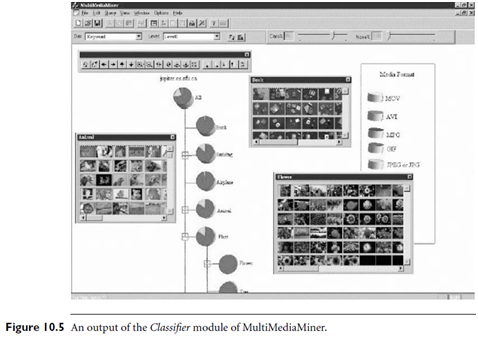Multimedia Data Mining
Multidimensional Analysis of Multimedia Data: To facilitate the multidimensional analysis of large multimedia databases, multimedia data cubes can be designed and constructed in a manner similar to that for traditional data cubes from relational data.A multimedia data cube can contain additional dimensions and measures for multimedia information, such as color, texture, and shape.
Let’s examine a multimedia data mining system prototype called MultiMediaMiner, which extends the DB Miner system by handling multimedia data. The example database tested in the MultiMediaMiner system is constructed as follows. Each image contains two descriptors: a feature descriptor and a layout descriptor. The original image is not stored directly in the database; only its descriptors are stored. The description information encompasses fields like image file name, image URL, image type (e.g., gif, tiff, jpeg, mpeg, bmp, avi), a list of all known Web pages referring to the image (i.e., parent URLs), a list of keywords, and a thumbnail used by the user interface for image and video browsing. The feature descriptor is a set of vectors for each visual characteristic. The main vectors are a color vector containing the color histogram quantized to 512 colors (888 for RGB), an MFC (Most Frequent Color) vector, and an MFO (Most Frequent Orientation) vector. The MFC and MFO contain five color centroids and five edge orientation centroids for the five most frequent colors and five most frequent orientations, respectively. The edge orientations used are 00, 22:50, 450, 67:50, 900, and so on. The layout descriptor contains a color layout vector and an edge layout vector. Regardless of their original size, all images are assigned an 8 X 8 grid. The most frequent color for each of the 64 cells is stored in the color layout vector, and the number of edges for each orientation in each of the cells is stored in the edge layout vector. Other sizes of grids, like 4 X 4, 2 X 2, and 1 X 1, can easily be derived.

The Image Excavator component of MultiMediaMiner uses image contextual information, like HTML tags in Web pages, to derive keywords. By traversing on-line directory structures, like the Yahoo! directory, it is possible to create hierarchies of keywords mapped onto the directories in which the image was found. These graphs are used as concept hierarchies for the dimension keyword in the multimedia data cube. “What kind of dimensions can a multimedia data cube have?” A multimedia data cube can have many dimensions. The following are some examples: the size of the image or video in bytes; the width and height of the frames (or pictures), constituting two dimensions; the date on which the image or video was created (or last modified); the format type of the image or video; the frame sequence duration in seconds; the image or video Internet domain; the Internet domain of pages referencing the image or video (parent URL); the keywords; a color dimension; an edge-orientation dimension; and so on. Concept hierarchies for many numerical dimensions may be automatically defined. For other dimensions, such as for Internet domains or color, predefined hierarchies may be used.
The construction of a multimedia data cube will facilitate multidimensional analysis of multimedia data primarily based on visual content, and the mining of multiple kinds of knowledge, including summarization, comparison, classification, association, and clustering. The Classifier module of MultiMediaMiner and its output are presented in Figure 10.5.
The multimedia data cube seems to be an interesting model for multidimensional analysis of multimedia data. However, we should note that it is difficult to implement a data cube efficiently given a large number of dimensions. This curse of dimensionality is especially serious in the case of multimedia data cubes. We may like to model color, orientation, texture, keywords, and so on, as multiple dimensions in a multimedia data cube. However, many of these attributes are set-oriented instead of single-valued.
For example, one image may correspond to a set of keywords. It may contain a set of objects, each associated with a set of colors. If we use each keyword as a dimension or each detailed color as a dimension in the design of the data cube, it will create a huge number of dimensions. On the other hand, not doing so may lead to the modeling of an image at a rather rough, limited, and imprecise scale. More research is needed on how to design a multimedia data cube that may strike a balance between efficiency and the power of representation.